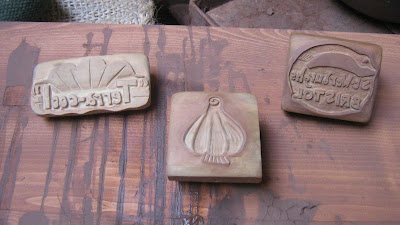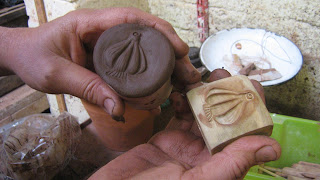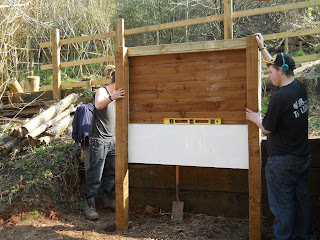Before the Vikings came to Iceland, it is thought to have had no permanent settlement (apart from the occasional visit by Irish monks looking for solitude). I was very interested to see how the strong Viking tradition of carving was faring in a country well-known for it's lack of trees.
Carved wood even played an important role in the founding of what would become the capital city, Reykjavik. When Ingólfur Arnarson sailed from Norway to Iceland in AD 870, he looked at the new land and then threw his ship's valuable carved wooden seatposts into the sea, saying that he would settle in the place where they washed up. They were found in an inlet with steam rising from it (from water heated by volcanic activity). That gave the place it's name - 'Reykjavik' means 'Smokey Bay'.
The prow of the Oseberg Viking longship burial, found at Oseberg farm near Tønsberg in Vestfold county, Norway and now housed at the Viking Ship Museum in Oslo.
Image from www.benbente.com
What trees grow in Iceland?
It seems that Iceland wasn't always as treeless as it is today.
From the fossil record, scientists know that during the Tertiary period (about 5 to 15 million years ago) the climate was much warmer and there were big trees such as Sequoia and large forests of Beech (Fagus spp.) growing.
During the Pliocene (from 5.3 to 2.5 million years ago), the climate had cooled a bit , but there were still huge forests of coniferous trees such as Pine, Larch etc.
All this changed when the land was covered with glacial ice during the Pleistocene (2.5 million to 11,700 years ago). No trees could survive under the huge glaciers which scoured the land. When they retreated, the first tree to recolonise was the tough downy birch (
Betula pubescens, shown below
) and this is still the most common native Icelandic tree, apart from the uncommonly-found rowan (
Sorbus aucuparia) and the even rarer aspe
n (Populus tremula). The tea-leaved willow can also be found, but it is usually more of a shrub than a tree.
Settlers Arrive
Even so, it is thought that when the first settlers arrived about 1140 years ago there were forests covering between 25% and 40% of the land area of Iceland. Some forests were destroyed by volcanic activity, but most trees were cut down to build with and to burn.
Burning wood was done partly to stay warm and partly to make charcoal, used in iron smelting and working to make vital tools. Grazing sheep stopped the regrowth of the cut trees and so by the middle of the twentieth century, there was less than 1% forest cover in Iceland. This lack of tree cover caused the added problem of increased soil erosion by the wind and rain, in a similar way to that seen when tropical rainforest is cut down.
The centuries preceding the twentieth had been a tough time for Icelanders and many emigrated abroad when international travel was possible in the nineteenth century. One factor in this hardship was a lack of wood to build with, stay warm or even to construct ships to leave in.
Replanting
At the end of the nineteenth century, people began to organise protection for the remaining areas of birch trees. In the mid-twentieth century, large planting programmes were put in place using suitable introduced species, such as Siberian Larch (Larix sibirica var. sukaczewii). These programmes are still going on today. Even so, most 'forests' in the country still have quite small trees, leading to this Icelandic joke:
"What do you do if you're lost in an Icelandic forest?"
"Stand up!"
(A lot of the information that I've used here came from an interesting article written by Throstur Eysteinsson, division chief of the Iceland Forest Service. You can read the whole thing here:
Meeting Jón Adólf Steinólfsson
One of the high points of our trip was meeting Jón Adólf Steinólfsson and his partner, Karin Esther Gorter.
Jón Adólf is a co-founder of the Society of Icelandic Wood Carvers and the Art Group Einstakir and Karin is an accomplished designer using glass lampworking techniques.
We had a great afternoon chatting about Iceland, carving and fantasy films, which they are both big fans of, amongst many other things. It was very interesting and quite inspiring to discuss carving with them.
Jón Adólf has studied in many places, having trained at the Hannes Flosason school of Woodcarving and the Kopavogur Visual Arts College in Iceland, the well-known Geisler Moroder woodcarving school in Austria and at two Italian schools of stonecarving. However, he freely admits that the most important and influential teacher that he has ever worked with is Ian Norbury, the well-known British woodcarver.
It was very interesting to have a look around Jón Adólf's studio at his current projects and to hear about upcoming ones.
One particularly interesting project will be carving a memorial crucifix to go on a battlefield mentioned in one of the Sagas, the Viking tales which are a hugely important part of Icelandic culture and history.
Although he's still working on lots of carvings in wood, stone carving is also very important. Jón Adólf showed me a piece of obsidian which he is currently carving into a life-size skull for a client. He also mentioned a job which is coming up, carving a 10 metre tall stone giant; part mythical troll and part his own creation.
I asked whether woodcarving is very popular in Iceland. He said that it is, with a lot of retired people taking it up in particular. This seems similar to Britain, where carving clubs often have a lot of older, retired members who can put in the time (and financial investment) that the carving process requires.
I was also interested to find out where the timber used to carve in Iceland comes from. Of course, a lot of it is bought or recycled. Jón Adólf uses a lot of basswood (which is similar to European limewood Tilia sp.) that he can get sent from the USA.
However, he also makes some very interesting carvings using driftwood found on Iceland's beaches. This timber originated in Siberia, where loggers floated cut trees downriver to be processed. Some logs were inevitably missed and these found their way out to sea, eventually becoming caught in currents, usually after being frozen into Arctic sea ice. When the ice melts, the timber is released and some washes up on Iceland's shores after perhaps over a century at sea. Jón Adólf said that the amount of driftwood that he finds is becoming less and less over the years. It is good to work with, although the salt and sand trapped in the wood can be tough on your carving tools. The pieces below and to the right were carved from driftwood:

During our conversation, Jón Adólf spoke about what an important resource the internet has been for him. Although he doesn't keep a blog, as that kind of writing doesn't really appeal to him, he maintains a website and a social media presence and links them all into each other. This has led to some interesting contacts, at one point a TV crew from Hawaii came to interview him about his work after locating him through the web. Karin is also very involved in the marketing and business side of the work and in maintaining a good online presence.
Another thing that he believes to be very important is networking with other carvers and makers and supporting them in their work.
For the future, Jón Adólf said that he is very interested in investigating blacksmithing and metalworking techniques. It seems appropriate, as carvers are so closely involved with the metal tools that allow them to create their carvings.
If you would like to see more of Jón Adólf Steinólfsson's work, you can visit his website (which is written in English):
http://www.jonadolf.com/index.html
Karin's beautiful glasswork can be seen on her English-language website:
http://www.karinesther.nl/






















































